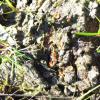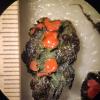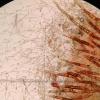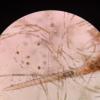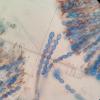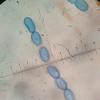
14-11-2025 16:26
 Marian Jagers
Marian Jagers
Hello everyone, On dead wood of Cytisus scoparius

17-11-2025 21:46
Philippe PELLICIERBonjour,Récolté sur bois pourrissant de feuillu

20-11-2025 14:14
Mick PeerdemanFound on the leaves of 'Juglans regia' in the Neth

20-11-2025 13:07
Mick PeerdemanIn January i found these black markings on the dea

20-11-2025 12:38
Mick PeerdemanDear all,Last week i stumbled upon a leaf of ilex

19-11-2025 23:21
 carl van den broeck
carl van den broeck
Dear guestIn Waardamme, Belgium, I found dozens of

19-11-2025 20:51
 Andreas Millinger
Andreas Millinger
Good evening,found this species on a felled trunk

19-11-2025 13:04
 Bruno Coué
Bruno Coué
Bonjour,je sollicite votre avis pour la récote
coprophilous Scutellinia
Warre Van Caenegem,
14-03-2025 23:29
Apothecia up to 5 mm
Hairs mostly bi- or trifurcated, sometimes simple, up to 600 µm, mostly between 300 and 500 µm, septated, the top of the hairs are hyaline,
Asci 205-240 x (12-)15-16 µm, 8-spored
Ascospores (16-)17-19(-20) x 10-12 µm, with regular spaced, low wrats
Found in Belgium, Antwerp, Mol, on 10 April 2024.
ITS has been sequenced, and matches 97,7% with Scutellinia sp. (Genbank Accession numbers MW540903.1 en MW540937.1), and 96,9% with S. fimicola (MW540964.1). The morphology does not match with S. fimicola, because of the smaller spores and the larger asci.
Are there any other fimicolous Scutellinia species known?
>Scutellinia_ITS
ACCCATCTGCGTACATTACCCGTTGCTTCCGCGAGGCAGTGATCTTCGATCACCTC
CCGACGATGGCTTGGGCCNTCCGGTGGGGAGCCCTCGTGAAAGGTTTACACCAA
ACCCTTGCATTTCTATGTCATCTGTCTGAAACTGTTAATAACAAATGTWAAAACTTT
CAACAACGGATCTCTTGGTTCTCGCATCGATGAAGAACGCAGCGAAATGCGATAA
GTAGTGTGAATTGCAGAATTCAGTGAATCATCGAATCTTTGAACGAACATTGCGCC
TCCTGGTATTCCGGGAGGCATGCCTGTTCGAGCGTCATTAATACCACACTCGAGT
CATTTTCGTGGCTCGGTCTTGGGAGAGGAGCGCAACTCGTCTGCCCTCCCTTCCG
AAATCCAATGGCGGAAAGCCCCACGTGCCCCGGCGTAGTAAGTCTTCTTTCGCTC
GGAACGTTTGGCGATCCTGCCGTGAACCCCCCACAAAATCATTTTACAGGTTGAC
CTCGGATCAGGTAGGGATACCCGCTGAACTTAAGCATA
Malcolm Greaves,
15-03-2025 10:04
Re : coprophilous Scutellinia
In the UK we have had at least 4 species which have been found on dung. Unfortunately none fit your specimen but it shows that at least some of the soil inhabiting species can also grow on dung.
Lothar Krieglsteiner,
15-03-2025 12:08

Re : coprophilous Scutellinia
my hyperborea/minor from the Alps that I want to re-examine soon was growing on cow dung, too.
I was surprised that it was definitely a Scutellinia and not a Cheilymenia.
I was surprised that it was definitely a Scutellinia and not a Cheilymenia.

